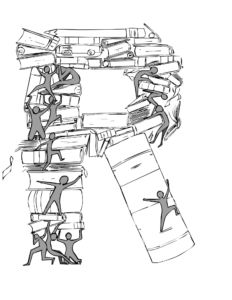Every year around the time when many Redwood seniors are just beginning to submit their college applications, counselors at Redwood have a lot to do. They write letters of recommendation, send transcripts to schools, and, perhaps most important, give schools a copy of Redwood’s School Profile.
The School Profile details a number of facts about Redwood—it talks about the required classes for everyone at Redwood, the Advanced Placement (AP) courses Redwood offers and a partial list of Redwood’s extracurriculars. Close to the bottom of the page it details the GPA needed to be in the first, second and so on deciles. It also gives the necessary GPA to be considered one of the top 5 percent of Redwood seniors.
The numbers needed to be in the top 5 or 10 percent of Redwood’s class of 2017 are ridiculous—a 4.22 puts you in the top 10 percent, and a 4.32 puts you in the top five. Straight As aren’t enough. To be in the top 10 percent a person would have to take about 4 honors or AP classes, and still achieve straight As, and to be in the top 5 percent requires straight As in a schedule that includes about 6 honors or AP classes. This only takes into consideration classes through junior year, meaning that these numbers go up significantly after a student’s senior year.
Redwood is already considered a competitive school, and to rank its students only puts undue stress on students to conform to incredibly difficult standards. Is a student with a 4.21 GPA appreciably different than a student with a 4.22 GPA? The obvious answer is no, but the student with the 4.21 is forced to put on the Common Application that they were in the second decile rather than the first.
This may not seem like a big deal, but many colleges publish the percentage of incoming students in the first decile of their high school graduating class. This means that colleges are incentivized to admit students who have higher decile rankings, even though the difference in GPA may be miniscule.
Colleges such as Cornell and Tulane have said that a majority of their applicants come from schools where they don’t rank, so people from schools like Redwood who aren’t in the first decile are at a disadvantage compared to people with similar academic profiles from different schools.
Although class ranking is theoretically another way to differentiate students in the college process, more often than not there are alternative, more helpful ways to distinguish students.
Many colleges, such as NYU and Chapman, say that in the absence of class rank, more time is spent looking through the school profile and other aspects of the applications—two methods of differentiating students that are much more helpful than rank.
All that ranking students accomplishes is to stress students out about the decile in which they’ll be placed. Especially at Redwood, where many people are looking at extremely selective universities, it can feel like the difference between the first and second decile could make or break an application.
Fortunately, there’s a solution to all this stress: Redwood, stop ranking students. Marin Catholic, Marin Academy, Drake, Branson, Saint Ignatius, Saratoga, Gunn and Miramonte are a diverse mixture of excellent, competitive public and private schools. The one thing they all have in common is that they decided to stop ranking their students.
Additionally, the counselors at Redwood have been trying to get rid of the ranking system for a long time, according to counselor Ian Scott, due to the anxiety it can cause high achievers who are not in their preferred decile.
The ranking system benefits no one. Colleges can already identify high achievers by their transcript and the additional information on the school profile; rank is an arbitrary way to slice and dice the senior class that can cause people at the top of their respective decile to be categorized as less hard-working than they actually are.
Especially with course offerings such as advanced journalism or drama that don’t offer a grade boost, it becomes much harder to stay in one’s preferred decile, meaning that ranking ultimately punishes people for following their passions.
Eliminating the ranking system at Redwood is an easy way to destress students and level the playing field for applying to college. Seniors are already stressed out enough by taking last-minute standardized tests, writing their applications and maintaining their grades. They shouldn’t have to be worrying about how their ranking will affect their chances of admittance, and if Redwood gets rid of the ranking system, they won’t have to.







